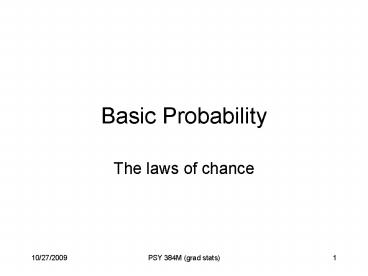Basic Probability - PowerPoint PPT Presentation
1 / 23
Title:
Basic Probability
Description:
a) discuss laws of probability, which are useful. b) define 'combinations' (and permutations) ... playing therewith leads to notions of: the frequency, m, of an event ... – PowerPoint PPT presentation
Number of Views:1380
Avg rating:3.0/5.0
Title: Basic Probability
1
Basic Probability
- The laws of chance
2
overview
- a) discuss laws of probability, which are useful
- b) define combinations (and permutations)
- c) use a) and b) to develop the binomial
distribution, which is useful.
3
experimental roots
- motivation game theory gambling
- apparatuses coins dice
- playing therewith leads to notions of
- the frequency, m, of an event
- the relative frequency, m/n, of an event
4
basic single die experimenthow many times, m,
will 4 (say) come up?
- intuition
- die has a symmetry suggesting all faces are
equally likely to come up - definition based on intuition
- the chance or probability that an event will
occur is
(equivalent to analytical view in Howell)
5
a priori probability
- let a be an event that can occur in A ways
- let B be the number of ways that anything else
can occur - then
6
assumptions we just made
- the truth of the (unique) case that all ways
are equally probable. - In other words, we assumed a null hypothesis.
- (how would we test it for a given die?)
- successive throws are totally independent
- In other words, the die has no memory.
- (which often violates our intuition)
7
results of the experiment
success was a roll of 4
8
(which leads to)an alternate definition
- which is the
- a posteriori probability
- or the relative frequency view from Howell
9
Two important theorems
- Theorem of total probability
- a.k.a. the additive law
- Theorem of joint probability
- a.k.a. the multiplicative law
10
Theorem of Total Probability
If A and B are independent events, then the
probability of A or B occurring is equal to the
sum of the probabilities of A and B. In other
words
(assuming A and B are mutually exclusive)
11
Theorem of Joint Probability
If A and B are independent events, then the
probability of A and B occurring is equal to the
product of the probabilities of A and B. In
other words
12
Conditional Probabilityand the full Theorem of
Joint Probability
The probability of A and B occurring is equal to
the product of one probability and its
conditional probability given the the other. In
other words
(which is just p(A)p(B) if A,B are independent)
13
Venn Diagrams and this stuff
mutually exclusive
not mutually exclusive
p(B)
p(A)
14
more general additive law
not mutually exclusive
15
probability example two coin flips
venn diagram
outcome matrix
toss two
0
1
0
toss one
1
A toss 1 is heads
both are heads
B toss 2 is heads
16
example calculations
p(A) p(B) 1/2
A
B
AB
p(A and B) intersection 1/2 1/2 1/4
toss two
0
1
p(A or B or both) union 1/2 1/2 - 1/4 3/4
0
toss one
(by the general additive law)
1
17
Combinations
is the number of ways (in any order) to get m
heads by flipping n coins, and is given by
- (I learned so you might see it written this
way too) - (also number of combinations of n things taken
m at a time. How can this be? What are the
things?) - (Permutations order matters, omit m!)
18
The Binomial Distribution
- Which we can break down as follows
- a p(head), b p(tail)
- second two termsp(one a and another and a b,
and another) is just a joint probability - the first term is the number of equally-likely
ways this could happen, so the probability of any
of them happening is is the sum of all C of the
probabilities (additive law)
19
simple binomial distribution
p(x heads) on one coin flip
20
binomial sample size
21
The Gaussian Approximation
mean na var nab
22
binomial p(heads)
23
Usefulness of the Binomial
- confidence limits on, for example, opinion polls
(the margin of error). - by extension, hypothesis testing (was our die
fair?) - the sign test (great for ordinal variables)
results

